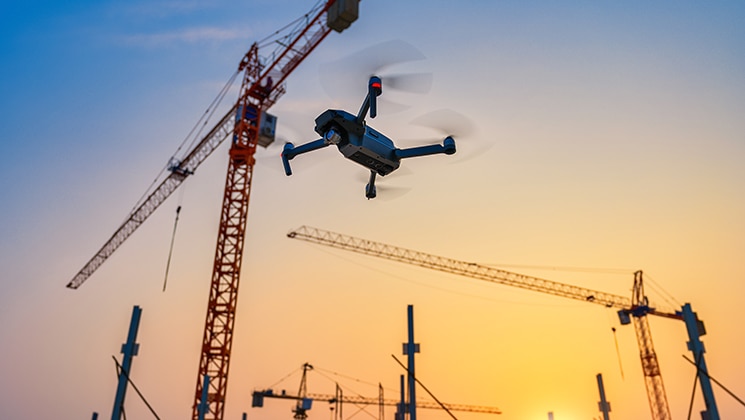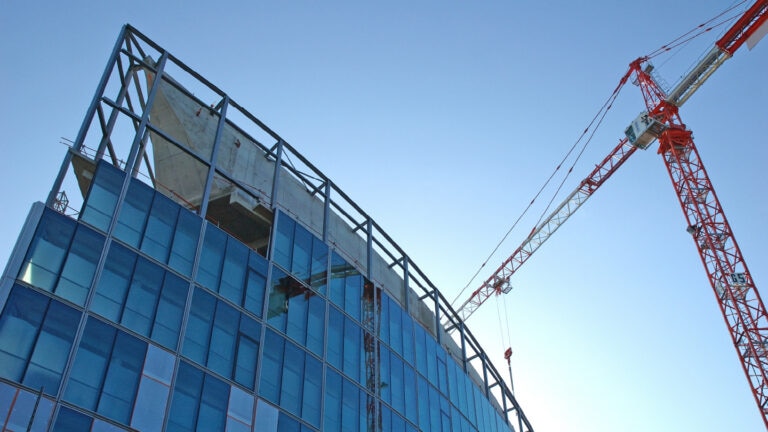
In today’s construction market, there’s little doubt that technology can hold transformative power.
Not only have new technological advancements led to greater efficiency in day-to-day operations, but they’ve also created new opportunities for companies to gain a competitive edge and focus on strategic growth.
There are several ways technology is making positive impacts on key priorities within the construction industry, including workforce, safety and risk management, and operational efficiency.
Finding solutions for construction labor challenges
Labor shortages in the construction industry remain significant and widespread. A survey by the Associated General Contractors of America (AGC) found that 91 percent of construction companies report having a tough time filling positions — which drives up costs and project delays. Preparing, attracting, and reskilling the future workforce are necessary steps in reducing that figure — and technology can help bridge the gap.
How can technology help with labor shortages? First, investing in cutting-edge approaches can help recruit and retain more young adults from tech-savvy generations into construction careers. Second, technology can streamline labor needs. By adopting tech methods to help reduce on-site worktime, such as using virtual construction tools like Building Information Modeling (BIM) and automating inventories and ordering, a contractor can better manage productivity levels and its workforce.
Addressing construction safety and risk
According to the 2021 Construction Technology Report by JBKnowledge, 44 percent of today’s contractors now have dedicated IT departments, and construction companies are using technology solutions to internally manage workflows like estimating, project scheduling, and project management as well as to improve safety. Here are some of the ways technology is helping with efficiency and safety:
Wearables
With wearable technology’s popularity and growth in consumer markets, the construction industry is now considering how to use different features to improve worksite safety. Some potential applications for wearable technology include monitoring an employee’s movements or vitals and providing real-time alerts if work conditions become dangerous. Smartwatches, for example, can detect fatigue and alertness in drivers and equipment operators; and other wearables can monitor physiological responses and help reduce the likelihood of heat illnesses by alerting workers of heat stress.
As another example, gear like augmented-reality glasses can provide workers with real-time guidance and detect errors before an accident, which, along with the proper training, could help improve productivity and safety. Plusses like these will likely fuel more experimentation with wearables and research on their effectiveness at improving safety.
Mobile devices
The importance of mobile capabilities has soared, the JBKnowledge report shows, with 85 percent of firms surveyed saying mobile is “important” or “very important” to their operations vs. just 59 percent who thought so a decade ago. Ninety-one percent of those surveyed use their smartphone daily for work purposes.
Use of smartphones, tablets, and other portable devices is quickly streamlining much of the construction process, from creating and approving blueprints to post-construction monitoring.
In terms of safety benefits, the adoption of mobile technologies can enable real-time communication with all members of a construction team as well as faster incident reporting and injury documentation, all of which can help reduce the risk of injuries and the cost of workers compensation claims.
Telematics
Telematics is a method of using phone apps, seatbelt monitors, AI sensors, and cameras to capture information on driving behavior and safety. Successful companies in every industry leverage data and technology to make smarter business decisions — and construction is no exception. By investing in telematics, firms are enabling data-driven decision making while protecting their employees, vehicles, and bottom line.
Boosting worksite efficiency with labor-saving strategies
Automating certain construction tasks, such as material handling, packing, or welding, not only allows for precision, speed, and accuracy, but can also represent significant time and financial savings. Here are three strategies that can help companies save time and improve accuracy, so projects are more likely to stay on track and on budget.
Robotics
Robotics continue to redefine certain aspects of the construction business – with significant benefits such as:
- Increased construction speed
- Less building-site construction waste
- Safer worksites and fewer injuries
From a financial standpoint, these benefits can also translate into lower construction, financing, and insurance costs.
Robotics can enable skilled workers to spend more time overseeing the project and work in conjunction with robots to become more efficient, especially in the areas of drywall installation, bricklaying, and demolition. Corobotics, like exoskeletons, can reduce the likelihood of work-related musculoskeletal disorders by reducing worker overexertion caused by lifting, lowering, and carrying construction materials, and prolonged overhead work.
“Robotics allow skilled workers to spend more time overseeing the project and work in conjunction with robots to become increasingly more efficient.“
While use is still not widespread, the compound annual growth rate for the construction robot market in the U.S. is expected to grow 12.9 percent between 2023 and 2028, according to one forecast. 3D printing, the practice of constructing objects using computer-aided drawings (CADs) and 3D printers to create materials that can be used in constructing buildings, is expected to hold significant share.
Workflow efficiency and virtual construction
The demand for BIM is likely to continue, as will BIM’s influence on how construction projects are bid and won. In fact, as a virtual construction method, BIM ranks as the most requested technology solution in JBKnowledge’s survey.
Why is BIM so popular? With BIM, project teams can evaluate a simulated model of a project at various stages in its lifecycle, from design and breaking ground, and right through to commissioning. It provides designers, contractors, and owners with a digital model of the project before the first shovel of earth is turned. This technique can help diminish risk and boost transparency by letting everyone see how project parts will fit together, from building materials to HVAC systems and landscaping. The workflow value comes into play as detecting problems and solutions digitally, before projects begin, helps avoid costly revisions later.
Drones
Fast-paced growth of commercial drones continues to make a big impact on the construction sector, with many construction companies using these tools today. For those companies that are interested in exploring emerging technology, drones have dominated all other tech offerings, rising by 10 percent in popularity this year.
What’s fueling such reliance? Construction workflows dependent on drones are expanding rapidly. These include:
- Site mapping
- Site documentation
- Structural inspections
- Percent-complete calculations
- Real-time surveillance video
In addition, these devices boast major time, cost, and safety benefits — which can translate into lower risk as well. For example, drones allow builders to leverage data to conduct preconstruction simulations. This gives builders the ability to test various models and designs, which ultimately helps reduce the chances of error once actual construction begins. Moreover, the ability to perform construction tasks remotely and unmanned can also decrease the risk of worker injuries.
For all these reasons, the JBKnowledge report concludes that drones have reached a tipping point and may be well on their way to being viewed as essential job site tools — instead of just a luxury.
Job site imagery
In a recent study, 26 percent of those surveyed believed that observational data from job site imagery is essential to a world-class safety program. From crane cameras to 3D imagery, job site imagery can be used to identify hazards, track progress of projects, and compare actual build to the specifications.
Construction defects
Technology is a key method to minimize construction defects. As AI becomes more sophisticated, contractors can incorporate it into their processes, which can help to avoid costly claims.
Water intrusion devices
Water intrusion can cause project delays, defects, mold, pollution, and more. Stopping it sooner than later can result in saving time and thousands of dollars. Fortunately the Internet of Things and cloud-based technology have eliminated cost and implementation barriers related to infrastructure, and water intrusion technology is becoming more common in the construction industry.
Climate resilience engineering
In a world marked by increasingly volatile weather events, contractors and city planners have started investing in resilient construction: the practice of building more robust buildings and infrastructure to protect communities and individuals from severe weather and other disasters. Leveraging analytics to aid in the anticipation of climate risk impacts can help firms build stronger the first time as well as retrofit existing structures.
Introducing technology brings new risk
The construction industry is counting on technology to help solve its labor shortage, improve worker safety, strengthen risk management, and boost efficiency and productivity.
To learn more about how we support the industry, visit our construction page.
Related insights
This website is general in nature, and is provided as a courtesy to you. Information is accurate to the best of Liberty Mutual’s knowledge, but companies and individuals should not rely on it to prevent and mitigate all risks as an explanation of coverage or benefits under an insurance policy. Consult your professional advisor regarding your particular facts and circumstance. By citing external authorities or linking to other websites, Liberty Mutual is not endorsing them.



